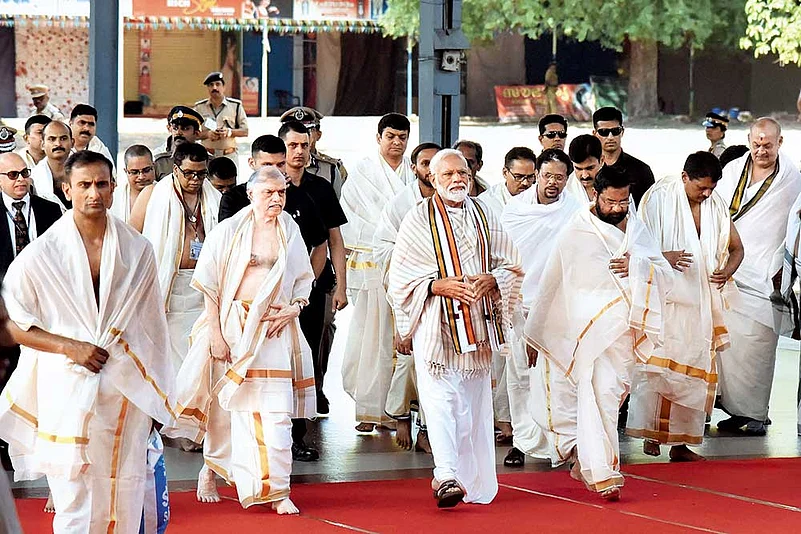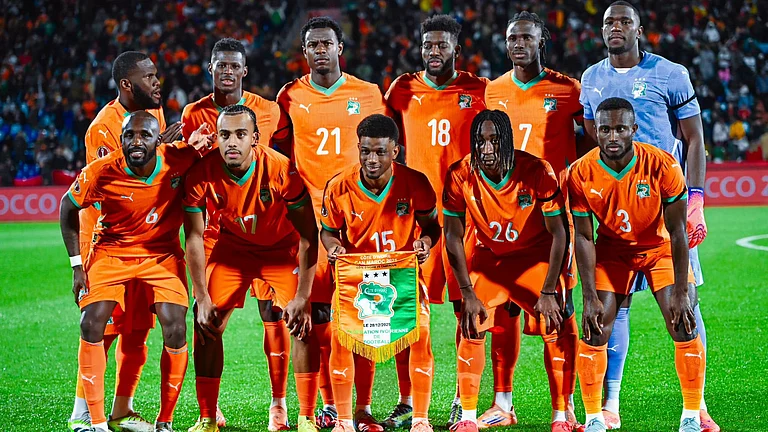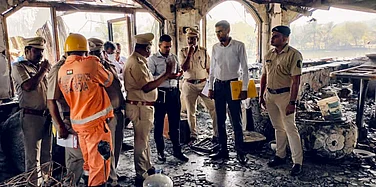The news from across the Vindhyas so far hasn’t been heartening to the BJP—except in Karnataka, where a political cliffhanger is playing out, close behind the party’s near-sweep in Lok Sabha polls. Chairing a meeting of the BJP’s key leaders last month, Union home minister Amit Shah said the party’s success story would be complete only when it conquers the region south of the Vindhyas that has been largely elusive to the saffron brigade for many years. Meanwhile, the Karnataka muddle is brimming with sub-plots, much of which is of the discordant JD(S)-Congress coalition’s own making, though aided by a BJP impatient to form the government.
Though it is the single largest party in Karnataka’s assembly, the numbers needed for the BJP to wrest power seemed a bit out of reach until July when, suddenly, 16 ruling coalition MLAs brought the H.D. Kumaraswamy government to a precarious perch. CM Kumaraswamy recently tweeted the flight manifest of a charter aircraft as proof that BJP men had been escorting Congress legislators to Maharashtra, where rebel MLAs had been holding out ahead of the vote of confidence in the Karnataka assembly.
The BJP’s growth in Karnataka began much before the Modi-Shah era, but the recent Lok Sabha results—in which the party bagged 25 of the 28 seats—were its best ever. Compare this with the BJP’s overall southern scoresheet—it got four out of 17 seats in Telangana, but drew a blank in Andhra Pradesh, Tamil Nadu and Kerala. With a firm foothold in Karnataka and Telangana, the party is looking to expand in a big way in the south. For that, it is taking cues from the impressive victories in West Bengal and Odisha, where it bagged 18 out of 42 and five of 21 seats, respectively. Enough lessons have been learnt from past follies and its time to script a new south story, say the BJP leaders in charge of the southern region. The focus has now been shifted to the assembly elections and the 2024 Lok Sabha polls.
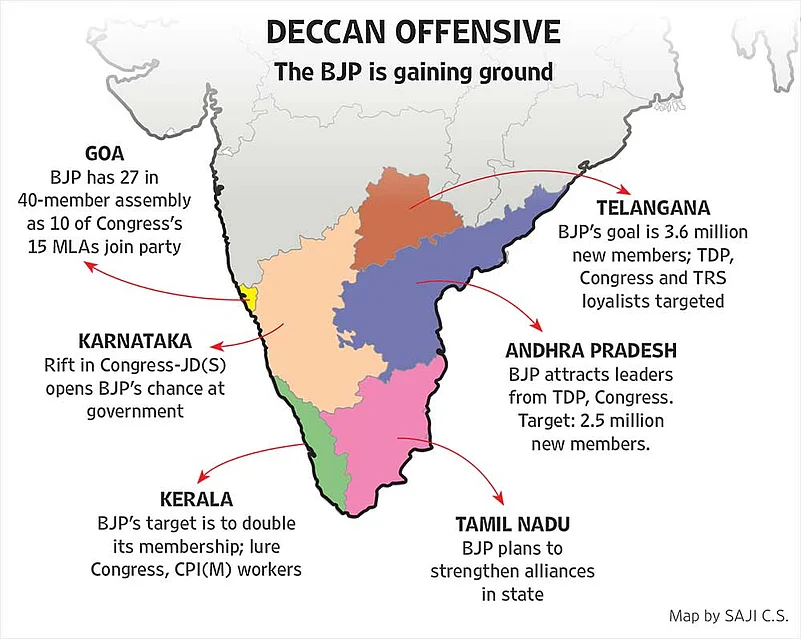
The south—Tamil Nadu, Andhra Pradesh, Telangana, Kerala, Karnataka and Pondicherry—accounts for 130 Lok Sabha seats. Speaking about expansion plans in the region, Rajya Sabha MP G.V.L. Narasimha Rao of the BJP says the party has set an ambitious target of adding 20 per cent more members in each state. A massive membership drive has already been launched. “We expect that the south will contribute to the 2024 Lok Sabha results just the way Odisha and Bengal did in 2019. We expect the two Telugu states and Kerala to deliver a large number of seats,” says Rao.
In keeping with its southern ambitions, the BJP is also looking to shed its image as a north Indian party. Party leaders acknowledge that they have to overcome some hurdles in the region, mainly due to linguistic, geographic, historic and religious factors, for making the desired perceptual change possible. Admitting that drawing more people from the south into the BJP demands bridging the north-south gap, senior leader Lalitha Kumaramangalam says the party is looking at solutions such as promoting competent southern leaders at the Centre. “We need to pay more attention to local demands and the problems of the states. We are mulling the interlinking of rivers to benefit the Cauvery delta farmers and its riverine states. We will also address the neglect of the major southern metropolises such as Bangalore and Chennai,” adds Kumaramangalam.
Political observers feel that as the BJP’s narrative of Hindutva fails to make any impact in the southern states, it may experiment with caste-based mobilisation instead. Analysts trace the BJP’s rise in Karnataka to the split in the Janata Dal in the late 1990s, which started the gradual shifting of the electorally important Lingayat community towards the BJP led by former CM B.S. Yeddyurappa, a Lingayat leader. The Vokkaligas, another populous community, are largely seen to back the JD(S), but the recent Lok Sabha results suggest that the BJP could have emerged as an option for some sections of the community, reckons political scientist Valerian Rodrigues. “The elite of the Vokkaliga community is strongly with the BJP,” he tells Outlook. “Political ambition and alienation of sorts led the Lingayats to the BJP, but with the Vokkaligas, the party has built up a religious kind of nexus.”
Rodrigues feels the BJP is following a strong regional, community and caste-wise strategy to strengthen itself in the south, most visibly in Telangana and among some of the OBC castes in southern Tamil Nadu. “It’s a three-pronged strategy—reach out to specific castes and communities, pick regions of priority and see where there are very fragile combinations that can be broken,” he says.
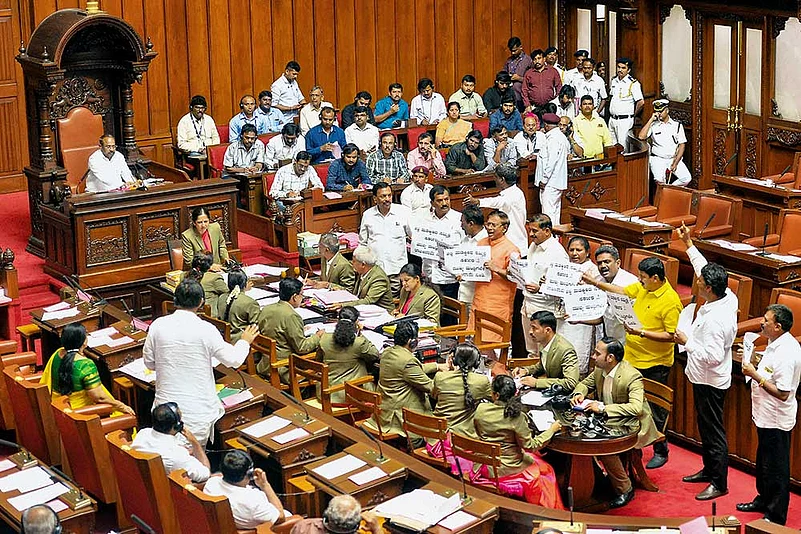
BJP MLAs demand the Karanataka CM’s resignation, July 16.
According to political analyst Sandeep Shastri, who believes it is simplistic to say that BJP uses a single agenda to build its base in the south, the BJP’s next stop after Karnataka will be Telangana, where it is emerging as the alternative to the ruling TRS led by K. Chandrashekar Rao. “It’s not that the BJP is looking for a quick fix turnover in the south,” says Shastri. “Even if the BJP emerges as the largest opposition party, it would be a huge achievement. See how they have emerged as Mamata Banerjee’s principal opponent in Bengal. It’s not about coming to power, it’s about emerging as a key player in the states.”
Building organisational strength is the key priority, admit leaders of the BJP, which has been aggressively recruiting from other parties. As Andhra Pradesh and Telangana have witnessed large-scale defections to the BJP from other parties, the leaders Outlook spoke to concede that it is indeed an emerging trend. “The way to grow is certainly by expansion,” says Narasimha Rao. “What is undemocratic about former MLA or MPs joining the BJP? (Former Andhra CM) N. Chandrababu Naidu had brought 23 YSR Congress MLAs into the TDP in the past five years and made four of them ministers. The Congress and others should look back and stop complaining.”
Agrees BJP general secretary P. Muralidhar Rao, who adds: “In the coming days, you will see more people from other parties joining the BJP and also our voteshare rising. In the next two years, the BJP will be the only opposition party in Andhra Pradesh and Telangana, where 36 lakh new members will be added as part of our membership drive. Both the states are going to witness major political realignment in the coming days.”
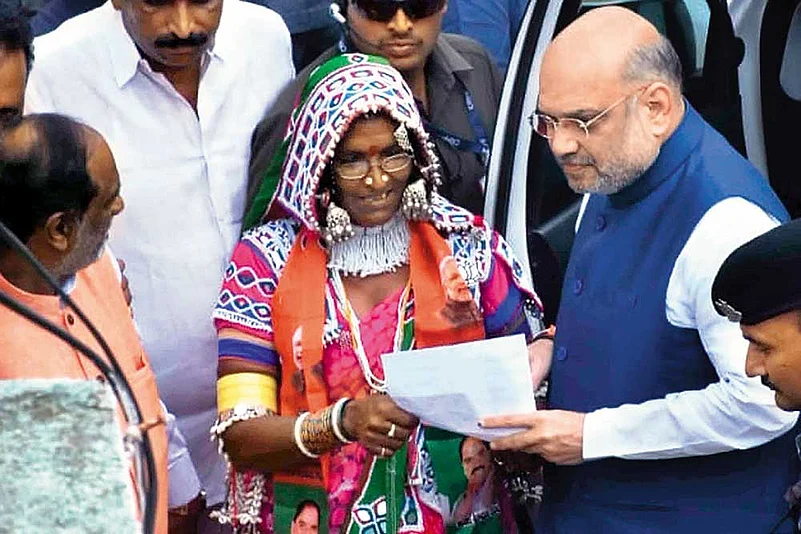
Amit Shah welcomes an adivasi woman into the BJP in Telangana.
AP and Telangana
In the two Telugu states, the BJP is trying to fill the political vacuum left by the decimation of two powerful parties—the TDP and the Congress—in the general elections. “We are working hard to build the party from the grassroots,” says Sunil Deodhar, the BJP’s national secretary in charge of Andhra Pradesh. “We are here for development, but won’t compromise on our ideology and tolerate conversion or appeasement of minorities for votebank politics.” The BJP has a fair chance if it can do a social churning to accomplish its dream to capture power in the 2023 assembly polls, reckons political commentator Kollu Anka Babu. “The BJP should strike a balance between the two economically powerful and influential communities—the Kapu and the Kamma—besides taking along the minorities and other backward communities,” he says.
With the massive exodus to the BJP from the TDP, the prospects of the revival of Naidu’s party appear quite bleak. “Revival is distant dream under Naidu,” says a senior TDP functionary. “We have little option but to look for greener pastures and safer havens. In the prevailing scenario, there is no scope for the Congress, which is dead and gone. As the YSR Congress led by Jaganmohan Reddy is dominated by his own community members, we were left with just one option—the BJP, which is emerging as the most powerful party in the country.”
Unlike Andhra Pradesh, where the BJP has to start from scratch, Telangana is smoother sailing. Though the party fared badly in the 2018 assembly polls, it bounced back by winning four of the 17 Lok Sabha seats this year. The party seizes an advantageous position if the OBCs—a major bloc in Telangana—choose to support it as the alleged ‘minority appeasement’ by KCR is not going down well with them. It’s also hoping to garner support from the influential Reddy community. BJP state unit spokesperson Krishna Sagar Rao claims that many Congress and TDP leaders, besides disgruntled TRS members, are willing to join the party. “Many senior leaders who had left us to join the TRS have returned. We are open to admitting anyone who is opposed to dynastic rule at the Centre and in the state,” he says. “Our party is changing with the times. It’s not an NGO or a religious outfit like the VHP.”
Tamil Nadu
Tamil Nadu continues to give stiff resistance to the BJP, leaving the party struggling to catch the pulse of Dravidian politics. Its central leaders say their priority is to strengthen alliances in the state. “We have to strengthen them well ahead of elections,” says MP Narasimha Rao. “We already have a formidable alliance with the AIADMK. It can do well.”
The party has also been handicapped by the absence of a charismatic state-level leader. The central leadership is apparently considering Nainar Nagendran for the role. The former AIADMK member joined the BJP two years ago. “I will do anything the party asks me to,” says Nagendran, who was a minister in the erstwhile J. Jayalalithaa government. Belonging to the powerful OBC Thevar community, he is expected to help the BJP grow in south and central Tamil Nadu.
Observers say the party may also try to piggyback on leaders like actor Rajinikanth to consolidate its position. “For the AIADMK, it’s all going downhill. The BJP is cleverly trying to create an alternative to the DMK alliance and may rope in leaders like Rajinikanth,” says Shastri.
Kerala
In god’s own country, the BJP-led NDA may have come a cropper again in the Lok Sabha elections, but closer analyses of the voteshare prove that there is a steady pattern of ideological Hindutva becoming electoral Hindutva in the state. “Steady increase in voteshare over the past three general elections shows a definitive gain for the party,” says Prof P.K. Yasser Arafath of Delhi University’s history department. “The micro details of the three elections show that the BJP has been growing fast. With this growth rate, which is most likely to persist, the Sangh parivar is not far away from capturing about half of the majority electorate in the next 10 years. A Lokniti-Centre for the Study of Developing Societies (CSDS) survey shows how the NDA successfully secured more than 38 per cent of the privileged caste vote in 2019. An undivided 50 per cent from the majority electorate would definitely help the BJP make strong inroads into Kerala.”
BJP’s state president P.S. Sreedharan Pillai is obviously a happy man. “Our voteshare saw a 56 per cent increase from the last elections,” he says. Political analyst J. Prabhash says the party is all set to gain in the state. “Though I wouldn’t say we are going to see an immediate sea-change in electoral results, the rise in the party’s voteshare is significant,” he adds.
Prabhash believes there are three factors to be considered. “The Sabarimala issue has certainly helped the BJP secure a number of votes. Then, the coalition with the BDJS and the Kerala Congress (Thomas) has given them a sort of legitimacy. Third is the fact that the Congress is getting weaker in many pockets.”
The BJP has set a target of doubling party membership in the state. “We want to bring more people, including members of the minority community, into the party,” says Pillai. With the BJP policy of wooing the minorities—already a few Christian leaders are with them in Kerala—the party is slowly but steadily making electoral gains in its last post to conquer in the south.
By Preetha Nair in Delhi, Ajay Sukumaran in Bangalore, G.C. Shekhar in Chennai with M.S. Shanker in Hyderabad and Sabin Iqbal in Kochi






